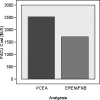Comparison of extended-release epidural morphine with femoral nerve block to patient-controlled epidural analgesia for postoperative pain control of total knee arthroplasty: a case-controlled study
- PMID: 21603330
- PMCID: PMC3096172
Comparison of extended-release epidural morphine with femoral nerve block to patient-controlled epidural analgesia for postoperative pain control of total knee arthroplasty: a case-controlled study
Abstract
Background: Because newer anticoagulation strategies for total knee replacement present potentially increased risk of neuraxial analgesia, there is movement away from using patient-controlled epidural analgesia (PCEA) for pain control. This concern opens the door for other regional modalities in postoperative analgesia, including the use of extended-release epidural morphine (EREM) combined with a femoral nerve block (FNB).
Methods: This study was a prospective observational chart review with the use of recent historical controls in patients undergoing unilateral total knee replacement. Outcomes of interest were 0-, 24-, and 48-hour postoperative pain scores using the visual analog scale (VAS); incidence of side effects; and time spent in the postanesthesia care unit (PACU).
Results: Postoperative pain scores at 24 and 48 hours in the EREM and FNB group (n = 14; 2.6 ± 0.6 and 5.0 ± 0.9, respectively) were comparable to the PCEA group (n = 14; 3.8 ± 0.6 and 4.2 ± 0.9). The PACU time was shorter in the EREM and FNB group (2.4 ± 0.3 hours) compared with PCEA (3.6 ± 0.3 hours, P = .02). No statistically significant difference was found in the incidence of side effects between the 2 groups.
Conclusions: The VAS scores at 24 and 48 hours indicate that EREM and FNB provide comparable analgesia to PCEA. The trend toward shorter PACU times represents an opportunity for cost-identification analysis. The study data are limited by their observational nature and the small number of patients involved; nevertheless, this study demonstrates a therapeutic equivalence to PCEA that may be more cost effective.
Keywords: Analgesia; extended-release epidural morphine; femoral nerve block; patient-controlled epidural analgesia; total knee arthroplasty.
Figures




References
-
- Fergusson M. Excision of the knee joint: recovery with a false joint and a useful limb. Med Times Gaz. 1861;1:601.
-
- Campbell W. C. Interposition of Vitallium plates in arthroplasties of the knee: preliminary report. Clin Orthop Relat Res. 1976. pp. 4–6. Oct. - PubMed
-
- Walldius B. Arthroplasty of the knee joint using endoprosthesis. Acta Orthop Scand. 1957;24((suppl)):19. - PubMed
-
- Coventry M. B., Upshaw J. E., Riley L. H., Finerman G. A., Turner R. H. Geometric total knee arthroplasty: I. Conception, design, indications, and surgical technic. Clin Orthop. 1973;94:171–184. - PubMed
-
- Rand J. A. Patellar resurfacing in total knee arthroplasty. Clin Orthop. 1990;260:110–117. - PubMed
LinkOut - more resources
Full Text Sources
